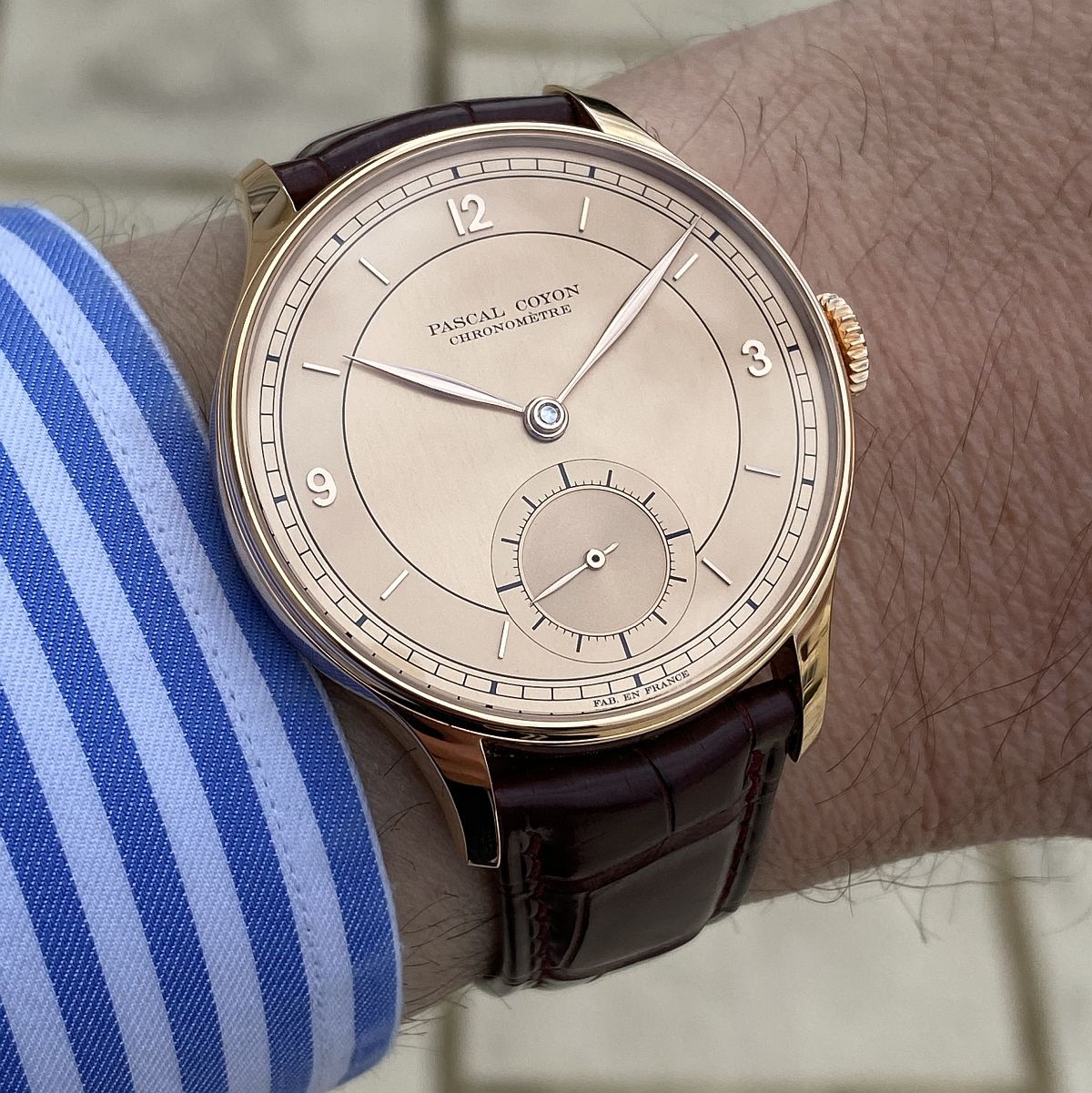
Hands on review of Pascal Coyon's Chronomètre Calibre 19 (Chronometer Caliber 19)
foversta


Pascal Coyon cannot be blamed for spending too much time communicating to the detriment of his workbench activity. Because Pascal is rather discreet about his latest movement, the caliber 19. But does he really need to be visible? After all, the quality of his work is recognized by connoisseurs and his best ambassadors are the customers who were seduced a few years ago by the Chronomètre 1900 and its magnificent caliber. The most curious among us had, however, seen pictures of the caliber 19 that had been published here and there, and information had been transmitted directly to collectors interested in this latest movement. This was enough to whet my curiosity. As the lucky owner of one of the Chronometers of the first series (and I know that many amateurs regretted not having been able to position themselves on this piece), I wanted to know more and above all to appreciate in a tangible way what distinguished the caliber 19 from the famous original caliber 1900. To something, misfortune is good... The health crisis allowed me a few weeks ago to get closer to Pascal Coyon's workshop located in the Landes and we were able to meet in the South-West region of France much more easily than in Paris. And that's how I was able to discover first-hand the caliber 19 and the prototypes of two configurations equipped with this movement.
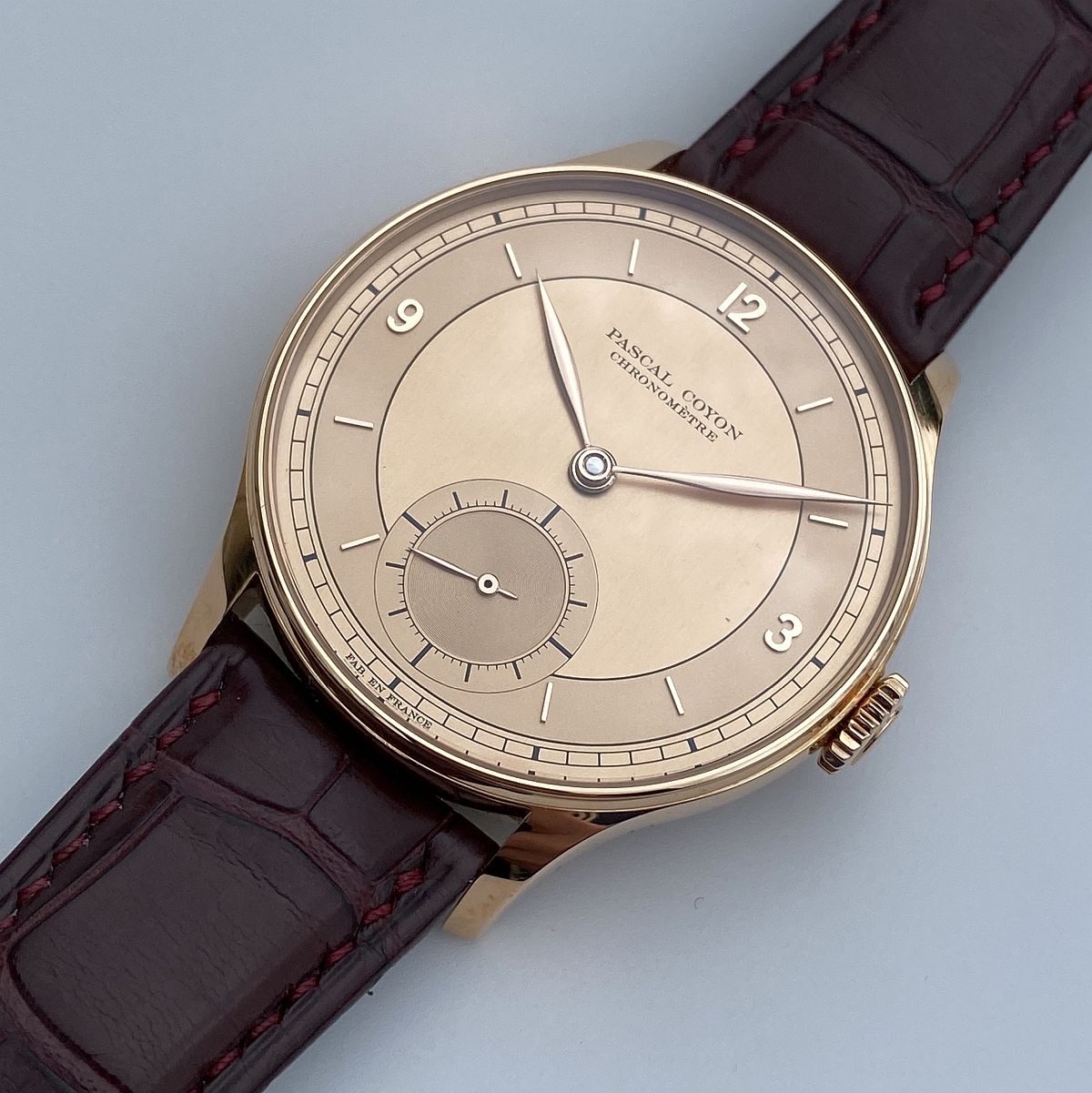
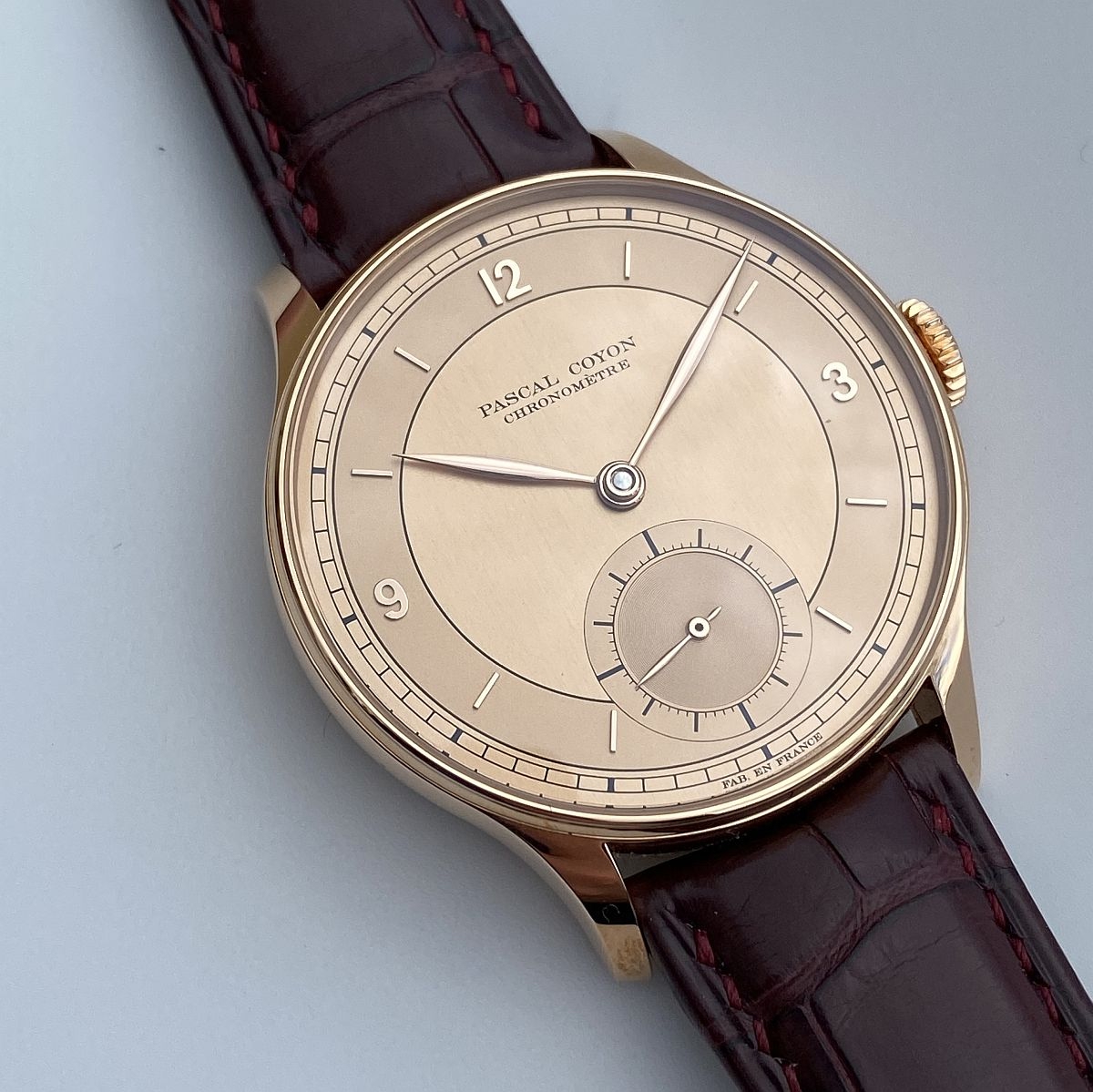
But at the end of the day, what does Pascal Coyon's proposal consist of? It can be summed up quite simply. The French watchmaker offers the possibility to acquire a classic chronometer watch in a precious metal case and driven by an exclusive movement, the caliber 19, made in the purest watchmaking tradition and offering an exceptional level of finishing. The customer will choose the type of finishing of the caliber 19 and then the elements of the casing to order a watch that will meet his expectations both from a technical and aesthetic point of view.
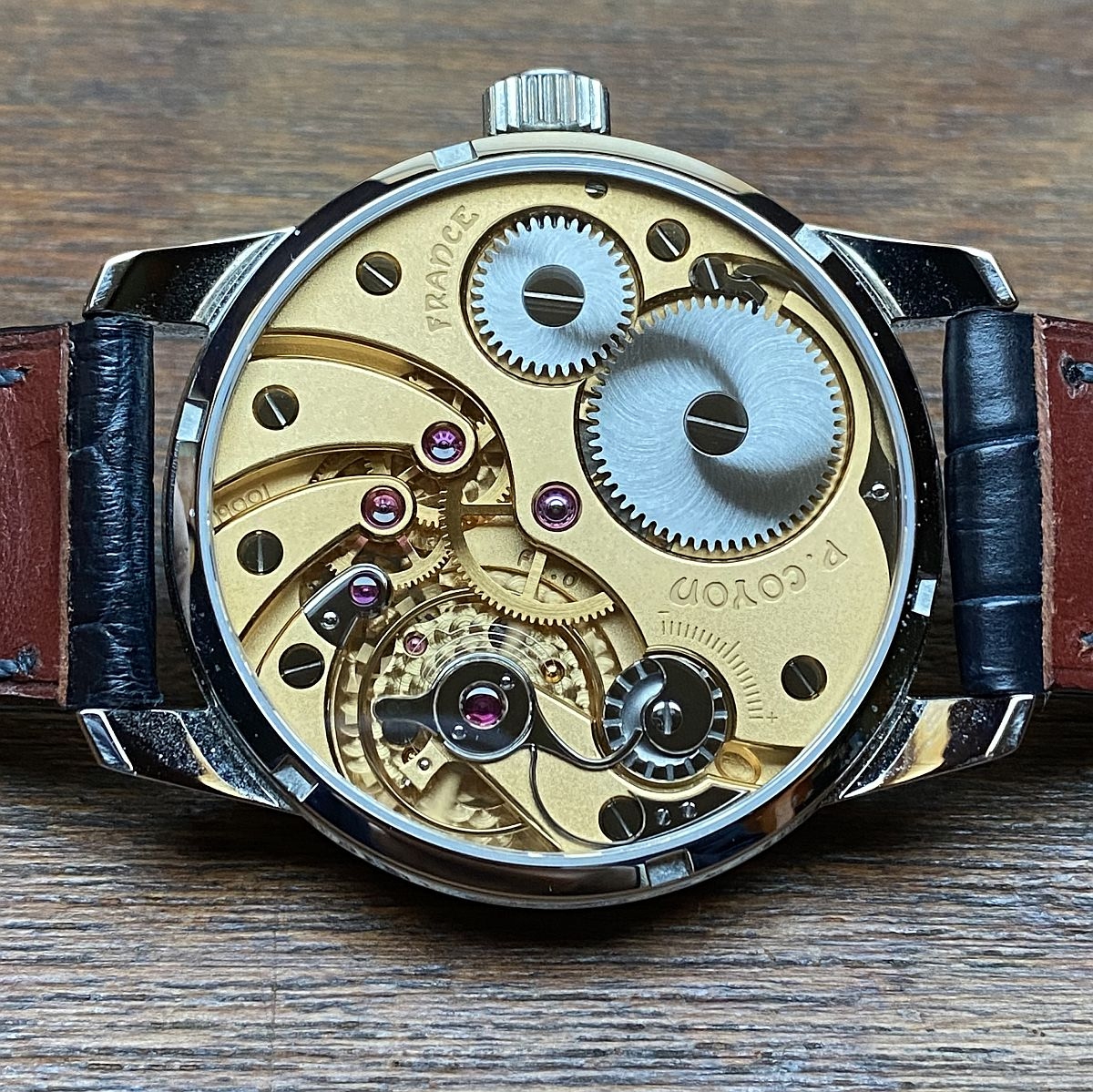
The cornerstone of Pascal Coyon's offer is therefore the caliber 19. His reference could lead one to believe that it is derived from the caliber 1900. Yes, in a way, because it shares the same spirit, that of handwind chronometer calibers, with a large balance and low frequency (2.5hz). But in reality the caliber 19 has nothing to do with the caliber 1900. This can be seen and felt. I remind you that the caliber 1900 took again the mobile elements of the Unitas caliber which were thereafter reworked by Pascal Coyon. Moreover, the bridges were revised. The result was spectacular and I consider today the caliber 1900 as one of the most accomplished movements having as a starting point the Unitas. Beyond the technical and decorative finishing (let's take for example the shape of the teeth of the gears), the 1900 caliber brings a lot of pleasure to everyday life, especially with the winding experience.
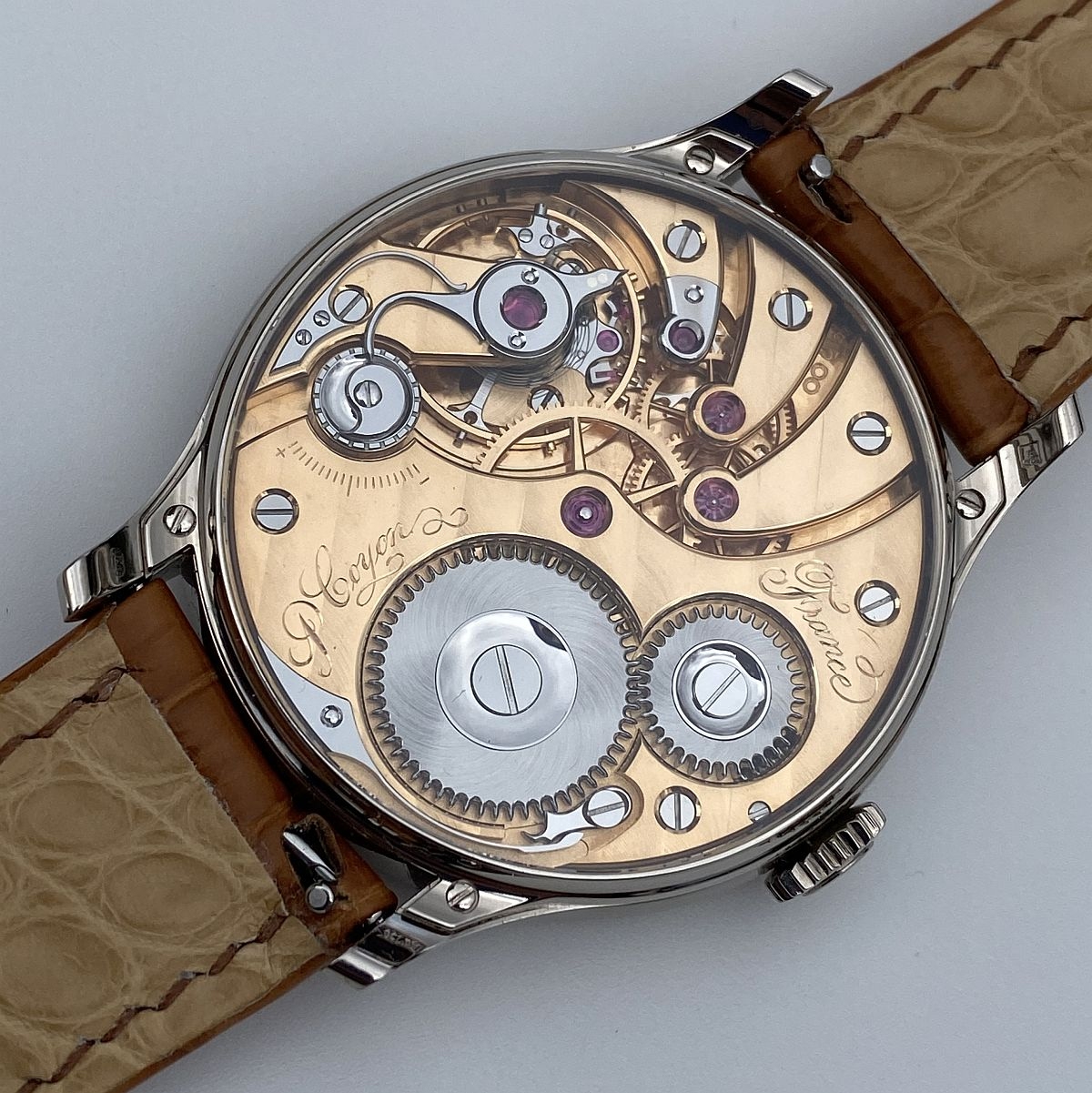
So, how did Pascal Coyon manage to create a caliber at an even higher level? It was a combination of two factors. The first and most important parameter is that the caliber 19 is exclusive. Only the winding stem is from a Unitas caliber. But for the rest, all the elements of the caliber are specific to it. This allowed Pascal Coyon to design this movement from a white sheet of paper while, of course, maintaining respect for the great principles of traditional watchmaking, which are to achieve chronometric precision and stability of movement, as shown by the diameter of the balance wheel and the low frequency. The energy of the barrel of the caliber 19 is not intended to increase the frequency or power reserve: it is intended to provide torque, the movement having to behave more or less identically at the end of the power reserve than at the beginning. In fact, this 16 line caliber (a very respectable diameter!) has a power reserve of 40 hours for a frequency of 2.5hz and one can clearly see from this data the priority of the use of energy.
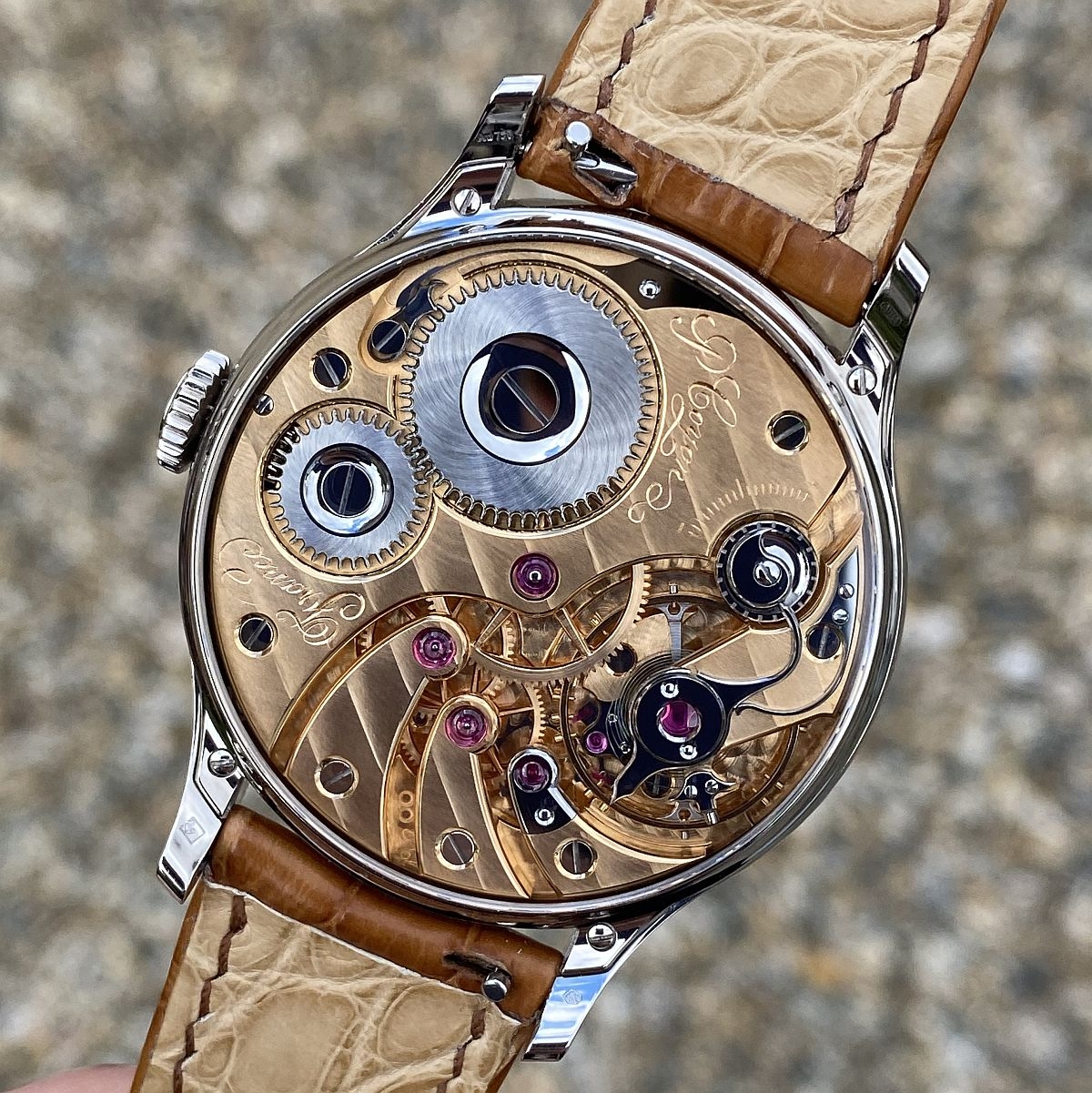
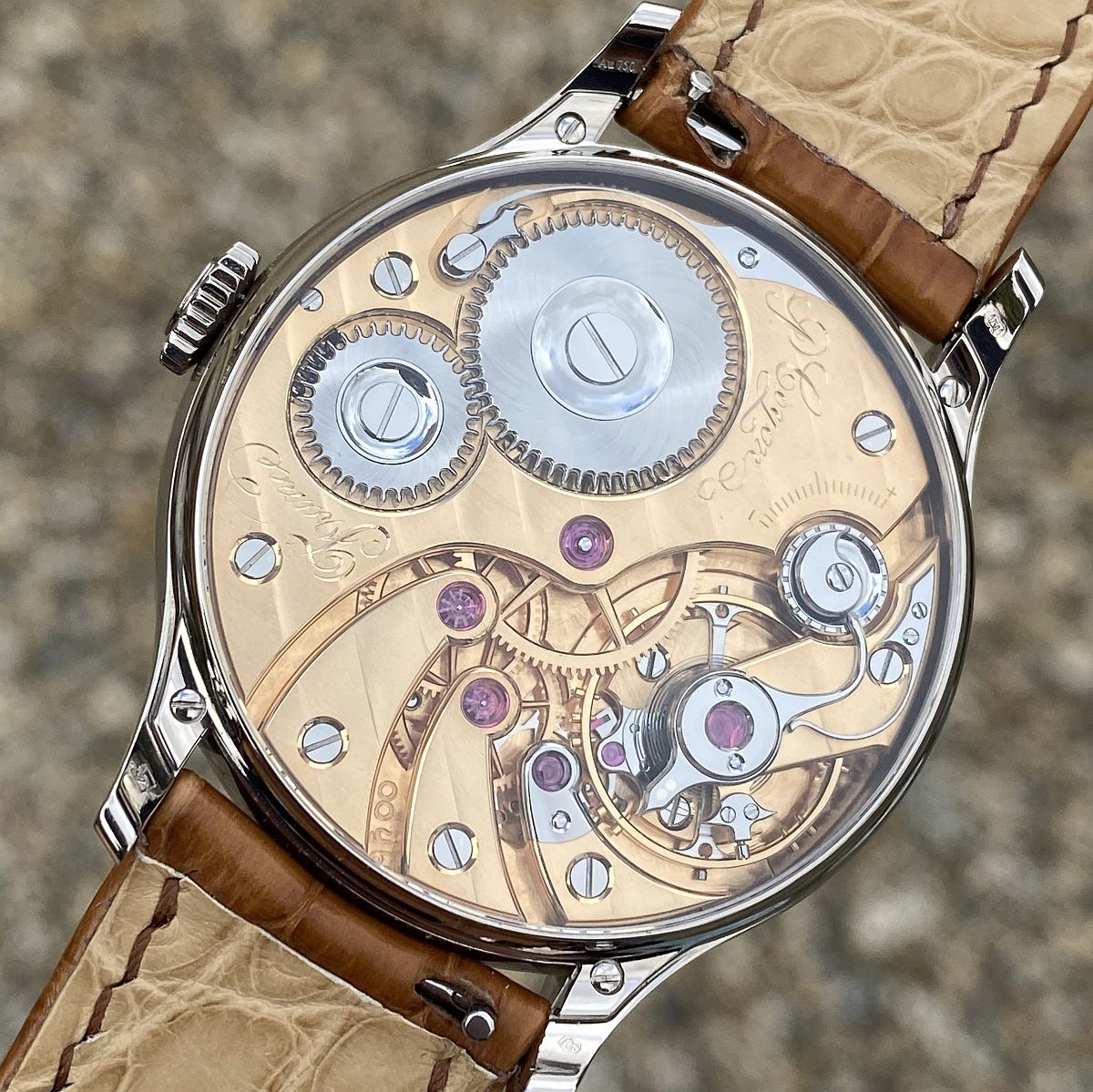
The second parameter is immediately perceptible: the technical and decorative finishes. The architecture of the caliber 19 is similar to that of the caliber 1900 and this is what makes it possible to better appreciate the differences in finish between the two movements. In fact, the caliber 19 is the result of a collective and family project. Three people are at the base of this project. Pascal, his daughter Barbara and Perrine, the daughter of Pascal's wife. Barbara is specialized in the execution of the finishing of the caliber parts: bevelling, polishing, beading, "grenaillage" etc... as well as in the finishing of the casing elements such as the gold or blued steel hands manufactured in-house. Perrine has also been trained in finishing and works particularly on 3D simulations in order to respond to customers' requests for representations of their requests. It is the joint work of Pascal, Barbara and Perrine that makes it possible to obtain this exceptional level of finishing.

If we had to summarize in only one characteristic the difference between the caliber 1900 and the caliber 19, it would be the way the latter captures and plays with the light in a much more spectacular way. It is this feeling that allows one to appreciate all the quality and subtlety of the work. Because I remind you that the caliber 1900 already had a very high level of finish. But with the caliber 19, all the details are pushed to the extreme. What surprised me the most was the finishing of the gears and the home-made wheels. The gears have flat-bottomed ogival teeth and the arms of the serges are beveled by hand. Of course, the gears are not the easiest elements to observe, but when you look closely at the execution of the center wheel, you are immediately seduced by its beauty and the precision of the execution. The crown wheel and the ratchet are much easier to observe and also provide a lot of pleasure. The contrast in the finish between the central and peripheral areas creates beautiful light reflections, as do all the steel parts, which are finished with a polished-blocked finish. I really like the shape of the ratchet, not to mention the ratchet and crown wheel teeth.
The rendering of the dials changes a lot depending on the light conditions:
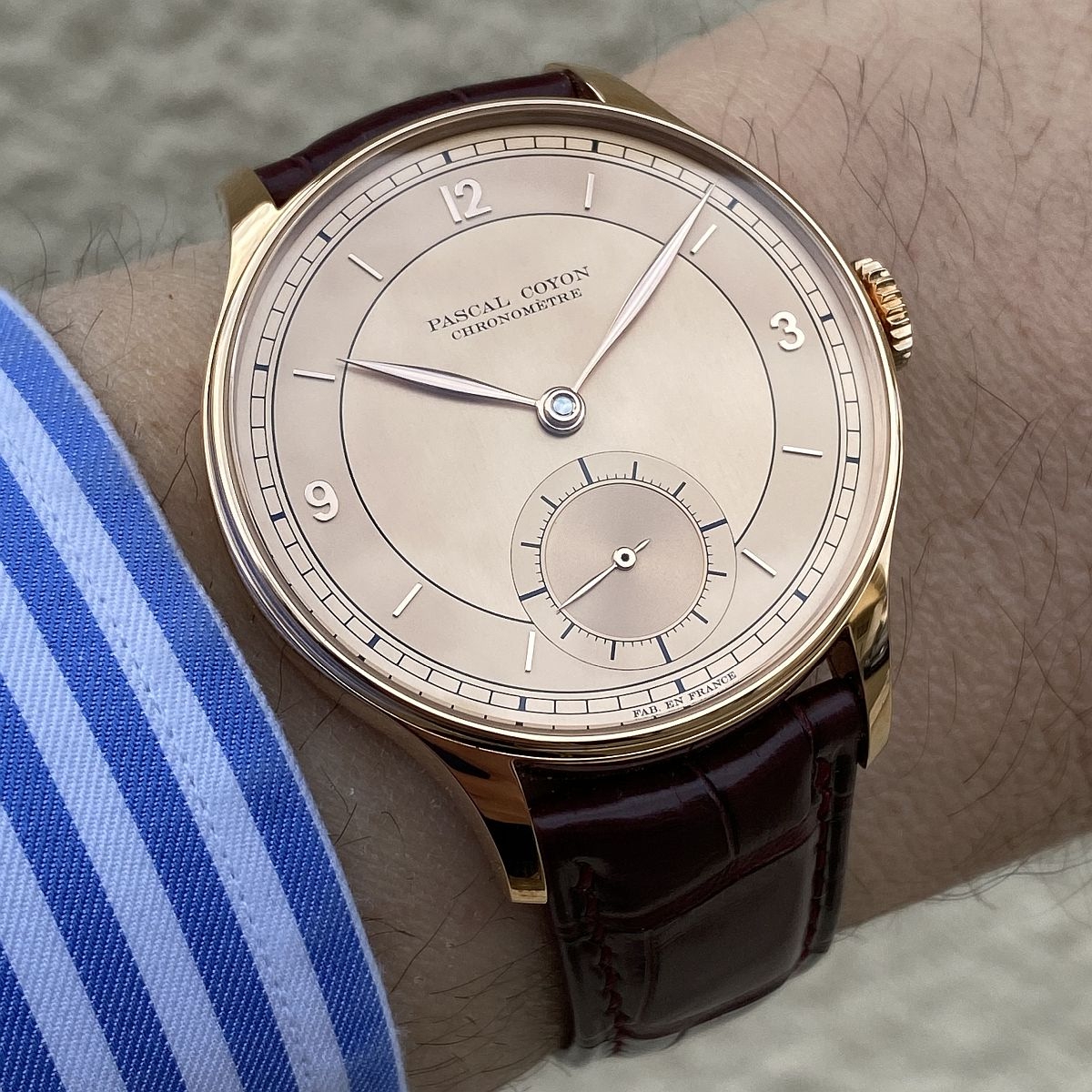
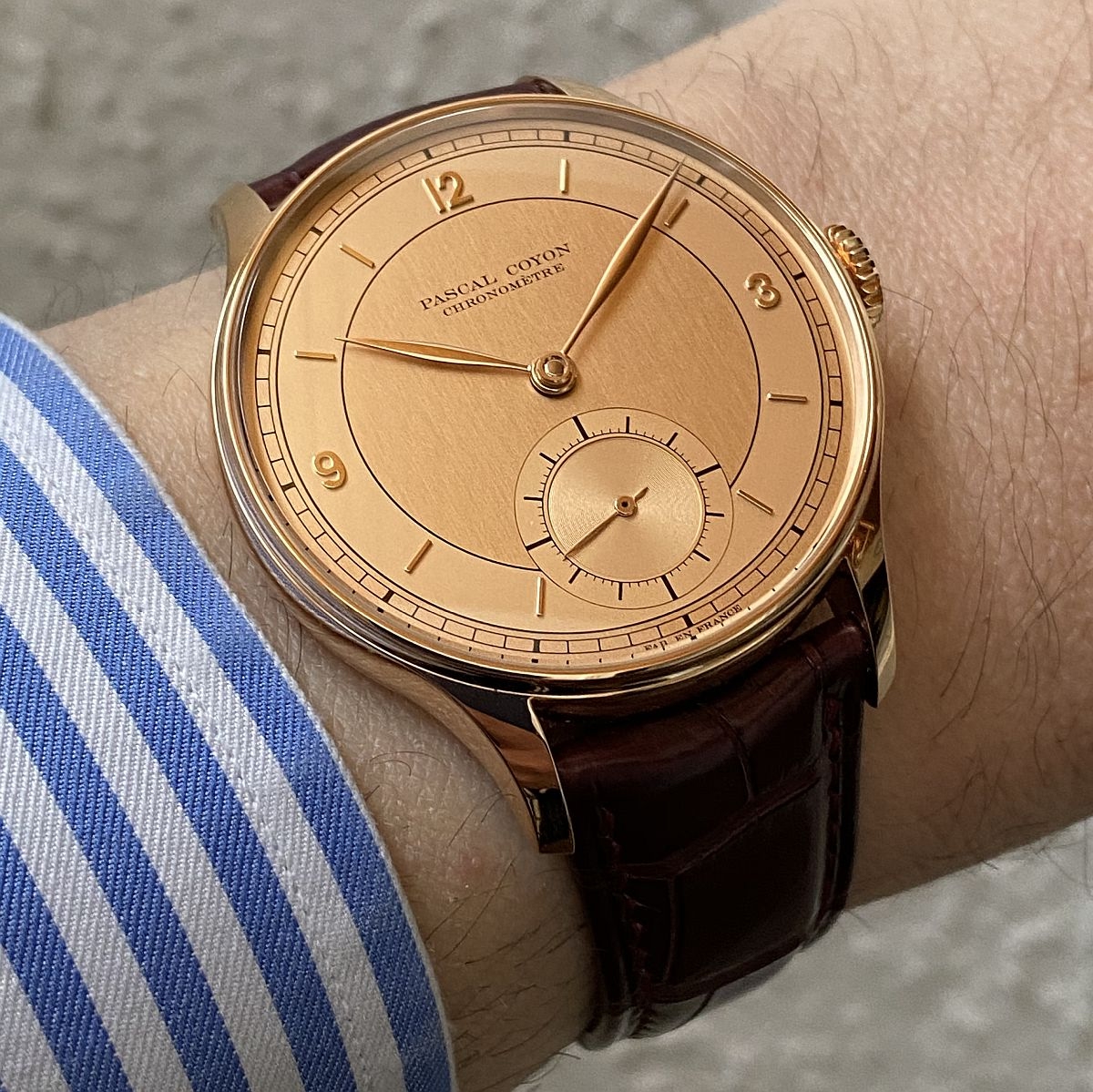

The bridges are obviously hand beveled and I particularly like their shape. The bridge of the escapement wheel is a masterpiece in itself thanks to its "two-tone" execution: brass and steel. As for the regulating organ, it is not to be outdone thanks to its spiral adjustment system. Note that the variable inertia balalnce wheel has a gold screw developed in the workshop. The balance-spring is blued to remind the old watches.
The observation of such a caliber causes amazement. The light reflections are multiple and above all the rendering changes very quickly according to the inclination of the rays of light. I am thinking for example of the dimensions of the bridges or the crown wheel and the ratchet. And the size of the caliber itself also contributes greatly to this success: it fills the case perfectly, which is very pleasant. Finally, and this is a specificity of low-frequency movements with a large balance, the ticking is majestic... I could only fall under the spell of this movement when I discovered it because it solicits sight and hearing with refinement and magic.
But as we all know, a single caliber is nothing. It has to be cased and nothing would be more frustrating than to see a casing out of step with its technical and decorative content. Fortunately, this is not the case in the context of the Chronometer Caliber 19. Pascal Coyon proposes this time not generic cases and dials as in the context of the Calibre 1900 but a complete casing which is specific and dedicated to the caliber 19. In addition, the hands give Barbara Coyon the opportunity to express her talent.
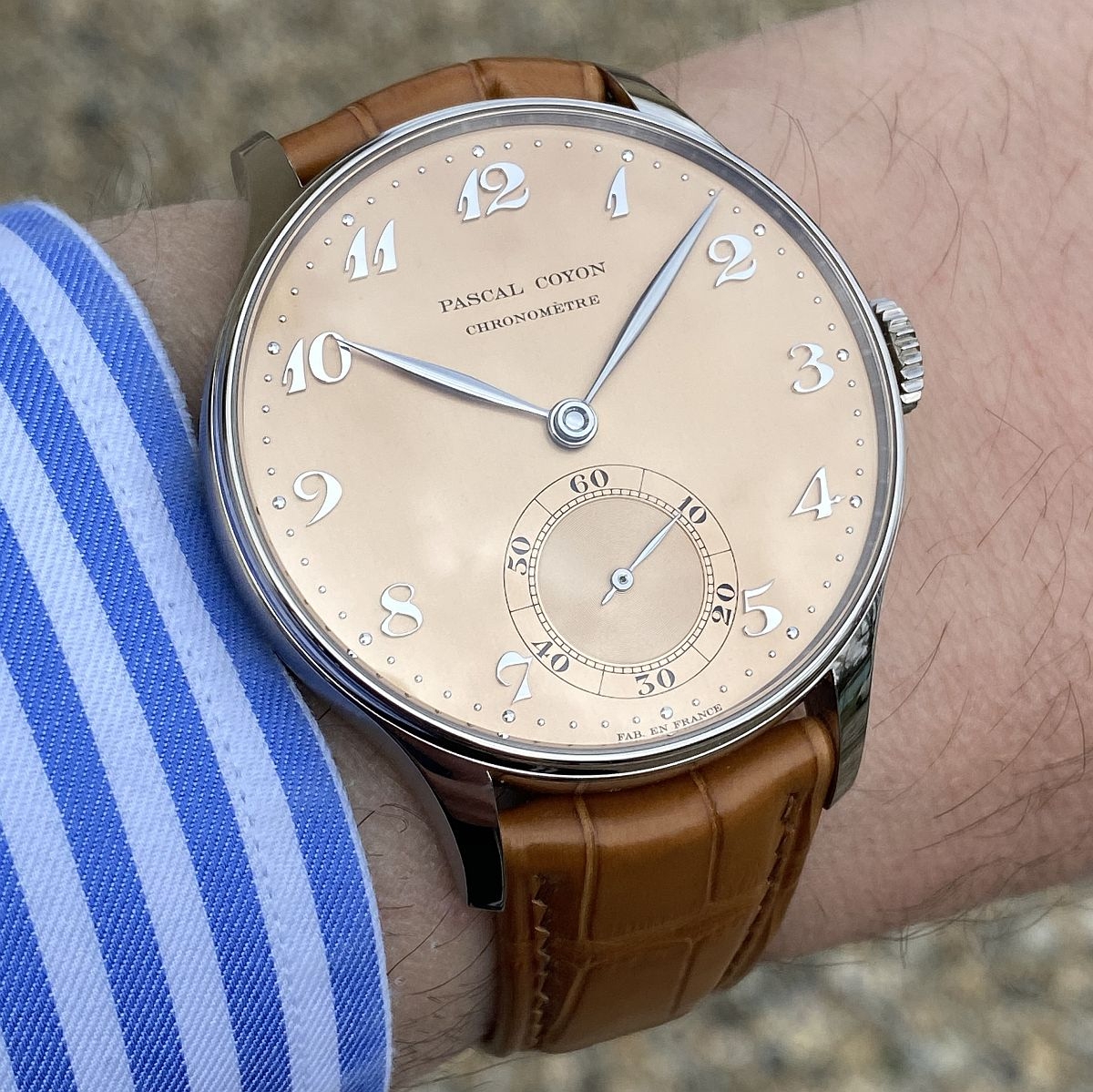
There are two basic types of dial. The first one is a sector dial with gold numerals and appliques and a peripheral graduation. The second is with applied numerals exclusively with a peripheral timer made of dots. The graduation of the second hand is obviously adapted to the context of the dial. These are classic, traditional dials that are not revolutionary from an aesthetic point of view but are perfectly adapted to the context of the caliber 19.
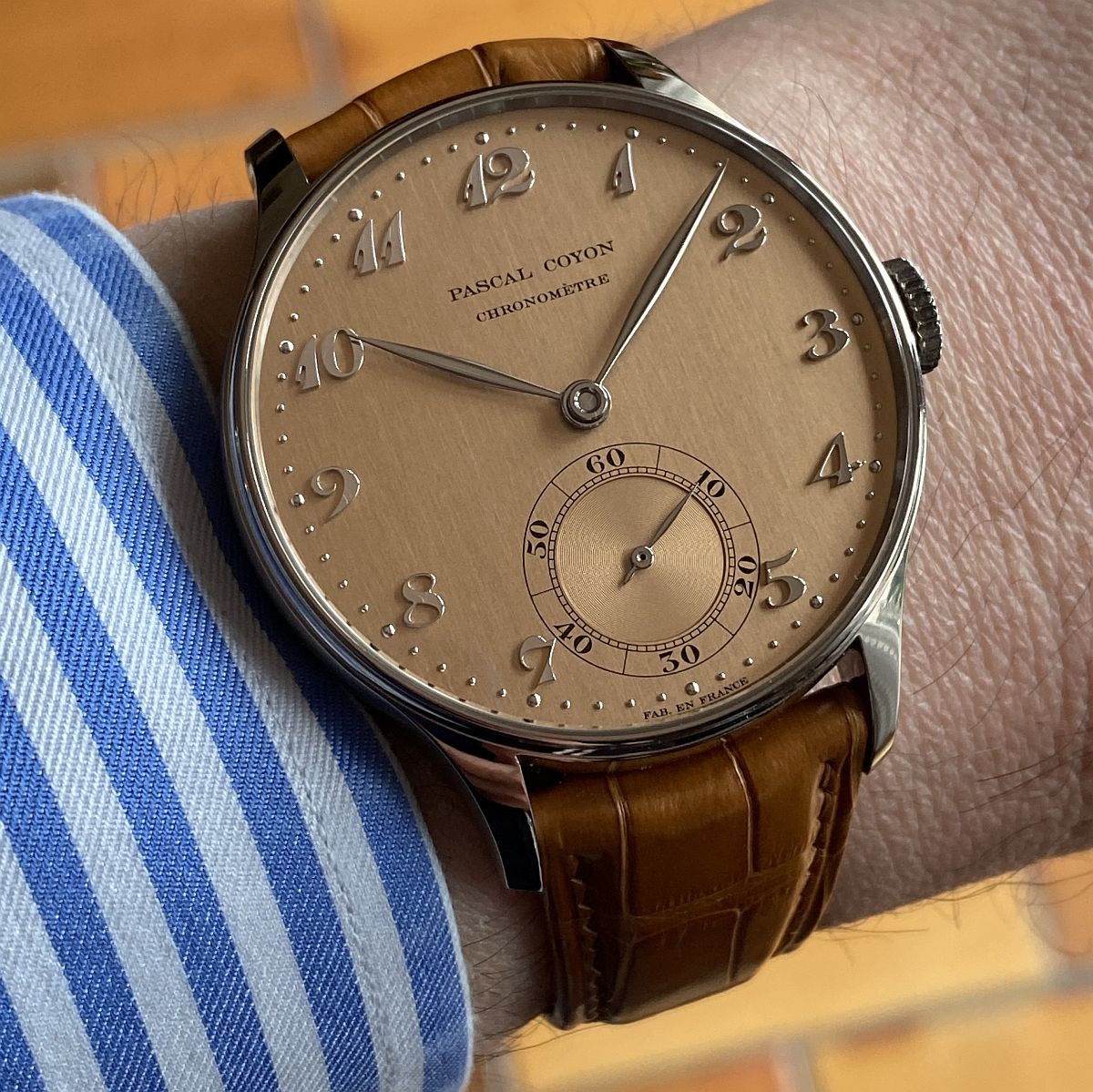
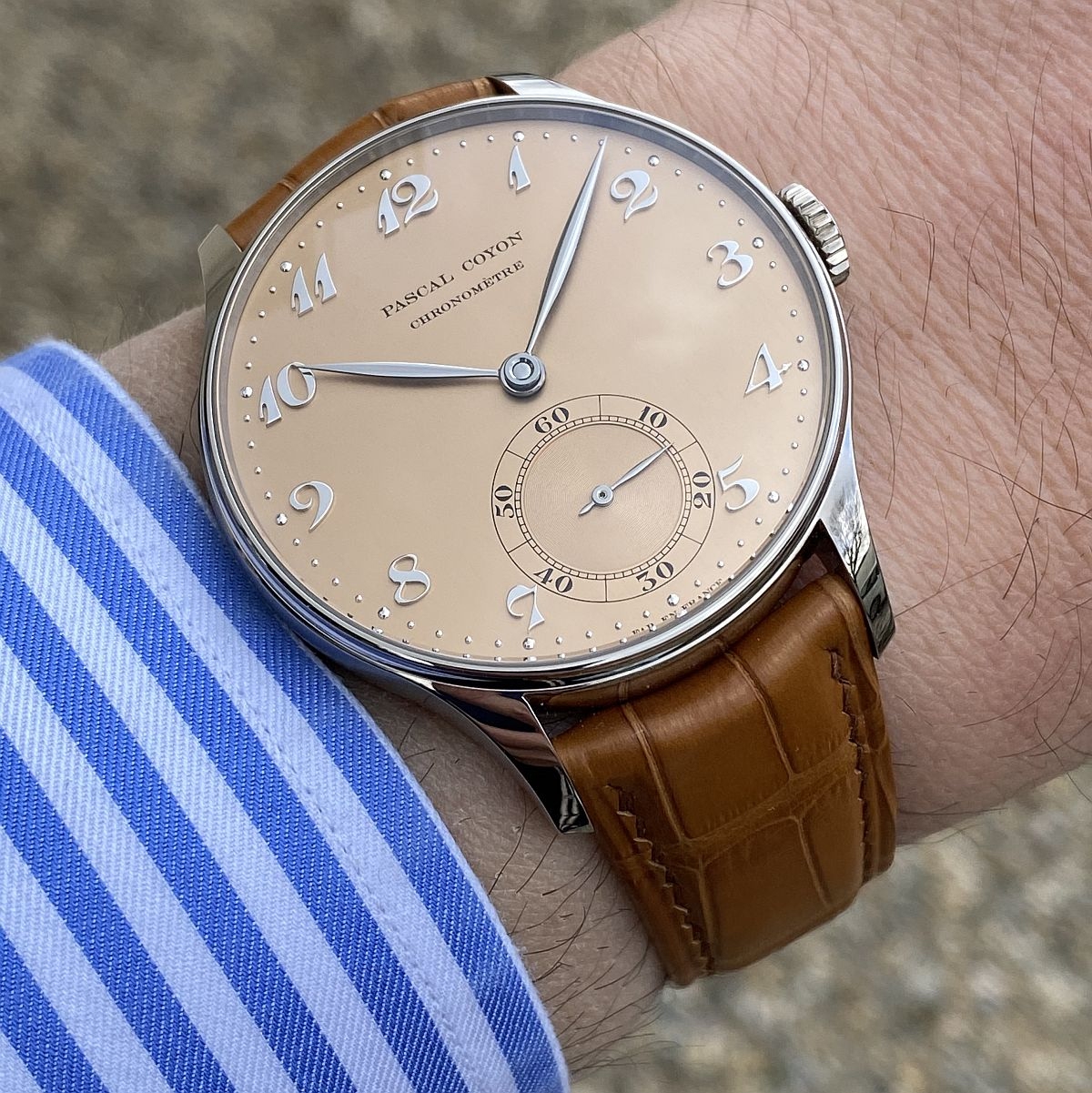
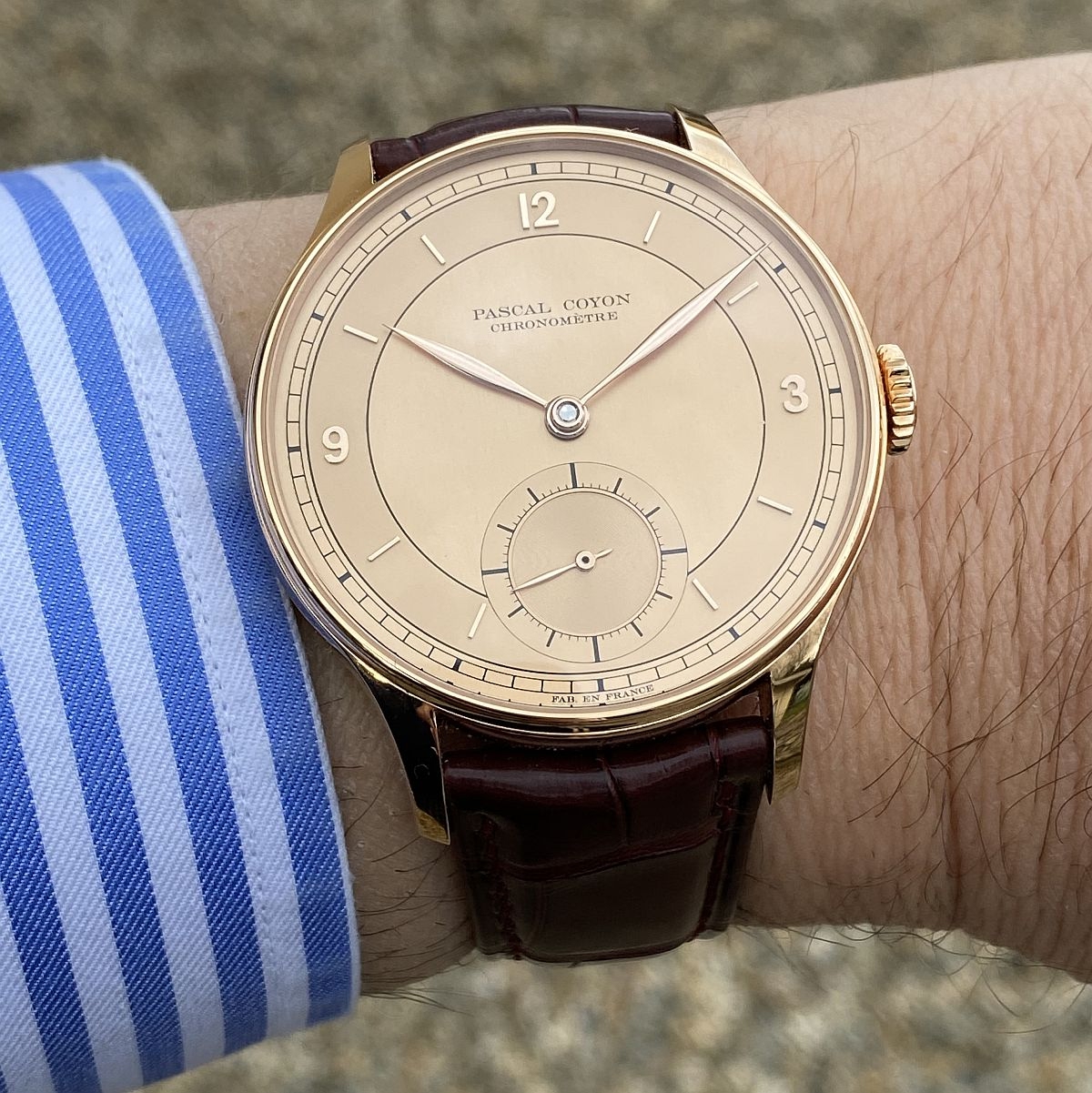
The Chronometer Caliber 19:

You note that I use a particular terminology: configuration. Because Pascal Coyon does not propose today a watch which would be declined in several official versions well standardized. He offers a very large choice of dials, hands around a case available in white gold, pink gold or platinum to dress the caliberv 19. In the end, the number of combinations is extremely high without forgetting, for a special price, the possibility to personalize certain elements such as, for example, by requesting a specific enamel dial. The only limits in this approach are the imagination and the tastes of the customer!

But at the end of the day, what does Pascal Coyon's proposal consist of? It can be summed up quite simply. The French watchmaker offers the possibility to acquire a classic chronometer watch in a precious metal case and driven by an exclusive movement, the caliber 19, made in the purest watchmaking tradition and offering an exceptional level of finishing. The customer will choose the type of finishing of the caliber 19 and then the elements of the casing to order a watch that will meet his expectations both from a technical and aesthetic point of view.
The caliber 1900:

The cornerstone of Pascal Coyon's offer is therefore the caliber 19. His reference could lead one to believe that it is derived from the caliber 1900. Yes, in a way, because it shares the same spirit, that of handwind chronometer calibers, with a large balance and low frequency (2.5hz). But in reality the caliber 19 has nothing to do with the caliber 1900. This can be seen and felt. I remind you that the caliber 1900 took again the mobile elements of the Unitas caliber which were thereafter reworked by Pascal Coyon. Moreover, the bridges were revised. The result was spectacular and I consider today the caliber 1900 as one of the most accomplished movements having as a starting point the Unitas. Beyond the technical and decorative finishing (let's take for example the shape of the teeth of the gears), the 1900 caliber brings a lot of pleasure to everyday life, especially with the winding experience.
The caliber 19:

So, how did Pascal Coyon manage to create a caliber at an even higher level? It was a combination of two factors. The first and most important parameter is that the caliber 19 is exclusive. Only the winding stem is from a Unitas caliber. But for the rest, all the elements of the caliber are specific to it. This allowed Pascal Coyon to design this movement from a white sheet of paper while, of course, maintaining respect for the great principles of traditional watchmaking, which are to achieve chronometric precision and stability of movement, as shown by the diameter of the balance wheel and the low frequency. The energy of the barrel of the caliber 19 is not intended to increase the frequency or power reserve: it is intended to provide torque, the movement having to behave more or less identically at the end of the power reserve than at the beginning. In fact, this 16 line caliber (a very respectable diameter!) has a power reserve of 40 hours for a frequency of 2.5hz and one can clearly see from this data the priority of the use of energy.
The reflections of light are spectacular on the caliber 19:


The second parameter is immediately perceptible: the technical and decorative finishes. The architecture of the caliber 19 is similar to that of the caliber 1900 and this is what makes it possible to better appreciate the differences in finish between the two movements. In fact, the caliber 19 is the result of a collective and family project. Three people are at the base of this project. Pascal, his daughter Barbara and Perrine, the daughter of Pascal's wife. Barbara is specialized in the execution of the finishing of the caliber parts: bevelling, polishing, beading, "grenaillage" etc... as well as in the finishing of the casing elements such as the gold or blued steel hands manufactured in-house. Perrine has also been trained in finishing and works particularly on 3D simulations in order to respond to customers' requests for representations of their requests. It is the joint work of Pascal, Barbara and Perrine that makes it possible to obtain this exceptional level of finishing.
Some examples of dials. The dial at the bottom right is in enamel. Note that the sector dial at the top left was the subject of a particular request because it uses the shape of the numbers of the other basic dial:

If we had to summarize in only one characteristic the difference between the caliber 1900 and the caliber 19, it would be the way the latter captures and plays with the light in a much more spectacular way. It is this feeling that allows one to appreciate all the quality and subtlety of the work. Because I remind you that the caliber 1900 already had a very high level of finish. But with the caliber 19, all the details are pushed to the extreme. What surprised me the most was the finishing of the gears and the home-made wheels. The gears have flat-bottomed ogival teeth and the arms of the serges are beveled by hand. Of course, the gears are not the easiest elements to observe, but when you look closely at the execution of the center wheel, you are immediately seduced by its beauty and the precision of the execution. The crown wheel and the ratchet are much easier to observe and also provide a lot of pleasure. The contrast in the finish between the central and peripheral areas creates beautiful light reflections, as do all the steel parts, which are finished with a polished-blocked finish. I really like the shape of the ratchet, not to mention the ratchet and crown wheel teeth.
The rendering of the dials changes a lot depending on the light conditions:



The bridges are obviously hand beveled and I particularly like their shape. The bridge of the escapement wheel is a masterpiece in itself thanks to its "two-tone" execution: brass and steel. As for the regulating organ, it is not to be outdone thanks to its spiral adjustment system. Note that the variable inertia balalnce wheel has a gold screw developed in the workshop. The balance-spring is blued to remind the old watches.
The observation of such a caliber causes amazement. The light reflections are multiple and above all the rendering changes very quickly according to the inclination of the rays of light. I am thinking for example of the dimensions of the bridges or the crown wheel and the ratchet. And the size of the caliber itself also contributes greatly to this success: it fills the case perfectly, which is very pleasant. Finally, and this is a specificity of low-frequency movements with a large balance, the ticking is majestic... I could only fall under the spell of this movement when I discovered it because it solicits sight and hearing with refinement and magic.
But as we all know, a single caliber is nothing. It has to be cased and nothing would be more frustrating than to see a casing out of step with its technical and decorative content. Fortunately, this is not the case in the context of the Chronometer Caliber 19. Pascal Coyon proposes this time not generic cases and dials as in the context of the Calibre 1900 but a complete casing which is specific and dedicated to the caliber 19. In addition, the hands give Barbara Coyon the opportunity to express her talent.
In any case, the case has a diameter of 39.8mm, which is an ideal size for a three-hand chronometer watch. As a reminder, the caliber has a proper diameter of 16 lines (i.e. 36mm) and it would not have been possible to use a smaller case. A larger case would not have made sense either because the dial is perfect as well because of the location of the second hand sector.

There are two basic types of dial. The first one is a sector dial with gold numerals and appliques and a peripheral graduation. The second is with applied numerals exclusively with a peripheral timer made of dots. The graduation of the second hand is obviously adapted to the context of the dial. These are classic, traditional dials that are not revolutionary from an aesthetic point of view but are perfectly adapted to the context of the caliber 19.
Personally, I have a preference for the sector dial that I find more dynamic. The numbers on the sector dial are, in my opinion, more contemporary than those on the applied dial and I find that the difference in finishing between the central and peripheral zones is a real plus. The applied numeral dial is purer and enlarges the perceived size of the watch. At the end of the day, the choice is made according to each person's taste because in each case, the finishing is flawless and above all worthy of the movement. And how can we not mention the element that is indispensable to the success of this watch, namely the hands? Several types of hands are available: blued steel or gold, Breguet type, leaf, marine, sword... Barbara Coyon brings a very particular care to the realization and the finishing of these hands which sublimate the dial. This is the reason why the choice of the pair of main hands is crucial. Needless to say that this selection is very delicate because each type of hands seems to marry perfectly with the dial. Again, it is a question of taste and the wish to give a more traditional or contemporary side to the watch.

The case is only available in precious metal. Anyway, considering the small series, a steel case would not fundamentally change the price of the watch. It is also classic in its interpretation but the result is visually much more fluid and elegant than with the cases available for the caliber 1900. The thickness at the top of the curved glass is 10.5mm which gives a very reasonable diameter (39.8mm excluding the crown) to height ratio. The lugs are very curved which allows the case to be well positioned on the wrist. The crown is easy to handle given its size without being too prominent which is a good point for the elegance of the whole. Note that it is possible to brush or polish the sides of the case middle side to bring a touch of personalization.

Given this level of excellence and execution standards, the selling price of the Chronometer Caliber 19 is at a much higher level than that of the Chronometer Caliber 1900. The prices are 30,500 euros without tax for the versions in white or pink gold and 39,500 euros without tax in platinum. Of course, these prices are revised if specific requests are made such as an enamel dial. When I discovered the watches and the caliber 19, I had no doubt about the relevance of this price level. The watches are perfectly realized and animated by an exceptional caliber that I consider to be one of the most beautiful handwind movements available today.

Admittedly, the Chronometer Caliber 19 is not a watch of great aesthetic originality. But it offers a design that is above all timeless and above all consistent with the movement. I was under the spell of this watch and the two examples of configuration that I discovered convinced me of the accuracy of the work of Pascal, Barbara and Perrine. The watch is primarily intended for discerning collectors looking for a timepiece with a chronometric vocation faithful to the purest watchmaking tradition. I can assure you that they will not be disappointed. In fact, the hardest part is to choose the right elements of the decoration and this step is a real headache! But once this step has been completed and the order launched, it will take between 12 and 18 months to receive the watch... The wait is long but logical and patience will be rewarded. The Chronometer Caliber 19 will, I am sure, bring great satisfaction to its owners: just the feeling brought by the winding operation demonstrates the exceptional nature of the work that is carried out. Decidedly, as I like to remind people regularly, France is becoming a credible country in the segment of fine artisanal watchmaking. And the fact that the Calibre 19 Chronometer comes from my native South-West region is even more pleasing to me!
Fr.Xavier
Comments:

BigFatPauli February 8th, 2021-13:18
Amazing post! I've been following Coyon for a few years now. What he is doing is the distillation of fine watch making. Bravo!

FabR February 8th, 2021-13:46
Thanks from a great review of a very interesting indie, FX -- those movements are a feast for the eyes! Cheers.

amanico February 8th, 2021-13:54
Wow, that's some great news. Outstanding in white gold. And this movement!!! Well done, Pascal.

SALMANPK February 8th, 2021-14:03
His work and pieces are so pure and fantastic, really wonderful


Mike H February 8th, 2021-14:17
Superb review about a stunning watch! Amazing work done by Pascal, very impressive. I hope that I shall have the opportunity to see it in the metal shortly...

Cpt Scarlet February 8th, 2021-15:34
Spectacular movement ... Congratulations to Pascal, Barbara and Perrine. Many thanks FX for bringing us this review.

sham1 February 8th, 2021-17:52
Fantastic post Francois but for once, no pros and cons!

Cozmopak February 8th, 2021-20:03
I hope to receive this watch sometime this year And am bursting with excitement

sham1 February 8th, 2021-22:17
I am in awe that with a movement the size of 36mm, the case is in 39.8mm. Unheard of but what a beautiful effect as nothing beats the sight of a movement filling up the case back.
0-10-10
Load More Comments
Next Article
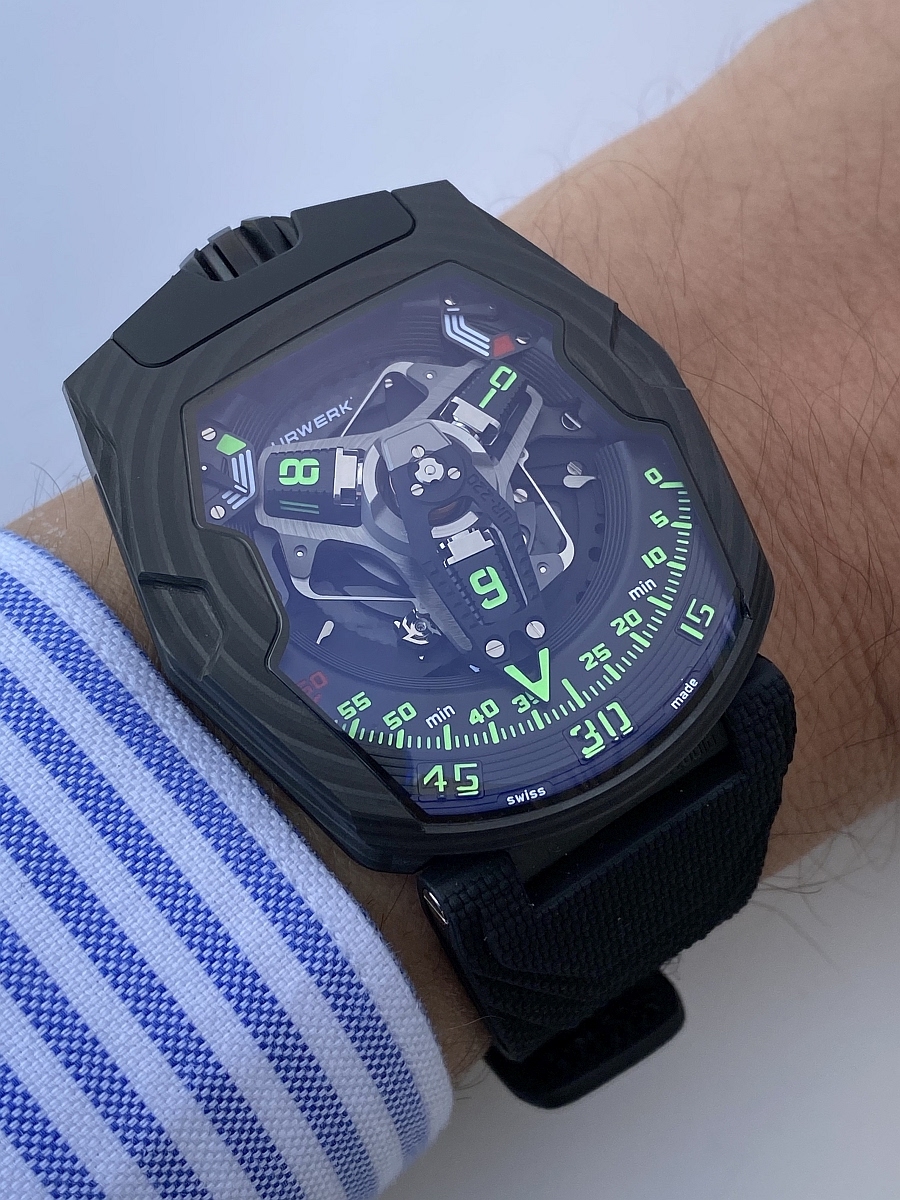
foversta


Hands on review of the Urwerk UR-220 "The Falcon Project"
foversta


The Urwerk watch I prefer is the UR-202 which stands out for its reinterpretation of the principle of wandering hours thanks to its telescopic minute hands. The time runs continuously, with the central carousel making a constant and permanent revolution. I also really like the UR-210 even though it has a different concept: the large retrograde hand. Basically both watches share the same central carrousel that carries three satellites, each with a rotating cube.
© 2017 - WatchProZine